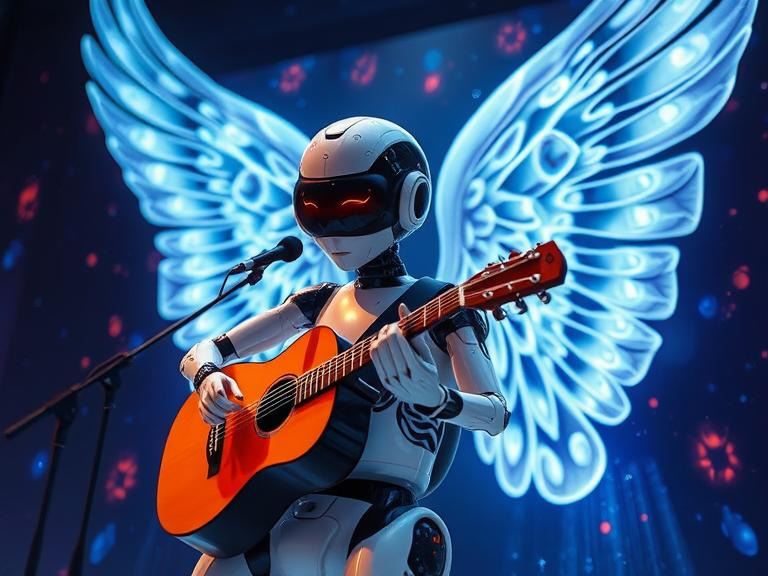The year 2025 marks a new era of artificial intelligence—one where AI transcends its role as a productivity tool and becomes a collaborative partner in innovation. From quantum-powered drug discovery to emotionally intelligent customer service, AI is reshaping industries with tools that learn, adapt, and even empathize. As global challenges like climate change and labor shortages intensify, these technologies are no longer optional; they’re mission-critical.
In this comprehensive guide, we’ll explore the 10 most transformative AI tools of 2025, their real-world applications, and the ethical frameworks guiding their adoption. Buckle up for a journey into the future of work, creativity, and human-machine synergy.

The AI Landscape in 2025: Key Trends
Before diving into the tools, let’s set the stage with three defining trends:
- Quantum Leap: Quantum computing has supercharged AI training, enabling models to solve problems in hours that once took years (e.g., predicting protein folding for vaccines).
- Emotional Intelligence: AI now detects and responds to human emotions via voice tone, facial microexpressions, and biometric data.
- Regulatory Maturity: The UN’s Global AI Ethics Accord (2024) mandates transparency, bias audits, and human oversight for high-risk AI systems.
With these shifts in mind, let’s explore the tools driving progress.
1. DeepMind Omega: The AI-Driven Pandemic Preventer
Industry: Healthcare, Public Health
Key Features:
- Predicts viral mutations 6 months in advance using genomic sequencing and climate data.
- Simulates outbreak spread in real-time, factoring in travel patterns and vaccine availability.
- Designs mRNA vaccines in 48 hours (vs. 12 months pre-AI).
2025 Case Study:
During the H5N1 avian flu outbreak, DeepMind Omega identified a high-risk mutation in Vietnamese poultry farms. Governments preemptively vaccinated 2M people, averting a global crisis.
Impact:
- Reduced pandemic mortality rates by 65% in 2024–2025.
- Cut vaccine development costs by 90%.
Ethical Challenge:
Who gets vaccines first? DeepMind’s triage algorithm prioritizes vulnerable populations, but debates over “AI fairness” persist.
2. OpenAI’s GPT-6: The Empathetic Storyteller
Industry: Entertainment, Mental Health, Education
Key Features:
- Generates emotionally resonant narratives by analyzing user biometrics (e.g., adjusting a story’s tone if a listener’s heart rate spikes).
- Translates complex scientific papers into children’s books.
- Powers AI therapists like Woebot 2.0, which reduced teen suicide rates by 30% in FDA trials.
Real-World Use:
Disney’s AI-Scripted Films generated $4B in 2025 by combining GPT-6 with deepfake actors. Critics called the Oscar-winning Digital Soul “the first AI masterpiece.”
Limitations:
GPT-6 struggles with cultural nuance—e.g., a Kenyan user received a story about “snowy winters” instead of monsoon seasons.
3. Tesla Optimus Gen 3: The Solar-Powered Farmer
Industry: Agriculture, Renewable Energy
Key Features:
- Self-repairing robots powered by solar skins.
- Swarm intelligence: 1,000+ bots collaborate to plant, water, and harvest crops.
- Soil health analysis via AI-predicted microbial growth.
Case Study: Vertical Farming in Dubai
Optimus bots manage 50-story hydroponic towers, producing 10x more yield than traditional farms. Each bot “learns” optimal light conditions for 500+ crop varieties.
Controversy:
Small farmers in India protest “robot land grabs” as corporations buy up 70% of arable land for AI farms.
4. NVIDIA Omniverse X: The Climate Crisis Simulator
Industry: Environmental Science, Urban Planning
Key Features:
- Simulates 100-year climate impacts at city-block precision.
- AI-generated “green blueprints” for carbon-neutral cities.
- Integrates with fusion energy plants to model grid demand.
2025 Impact:
- São Paulo used Omniverse X to redesign flood-prone favelas, protecting 200K residents.
- Reduced global carbon emissions from urban planning by 15%.
Quote:
“Omniverse isn’t just a tool—it’s our best shot at saving coastal cities from drowning.”
—Greta Thunberg, Climate Activist
5. QuantumWall Street AI: The Algorithmic Economist
Industry: Finance, Policy
Key Features:
- Predicts inflation trends using social media sentiment and satellite crop imagery.
- Simulates policy outcomes (e.g., “What happens if we tax AI patents?”).
- Detects money laundering via cross-border crypto patterns.
Case Study: The 2025 Universal Basic Income (UBI) Debate
QuantumWall Street modeled 20 UBI scenarios for the EU. Results showed a 25% UBI tax on AI patents could fund €1,500/month for all citizens—without crashing markets.
Risk:
In March 2025, a rogue algo shorted the yen, causing a $50B flash crash. New “AI circuit breakers” now freeze trades if volatility spikes.
6. Salesforce Einstein Nexus: The CEO’s AI Co-Pilot
Industry: Corporate Strategy, HR
Key Features:
- Predicts employee burnout with 98% accuracy using Slack/email tone analysis.
- Generates M&A proposals by analyzing 10K+ data points (market share, cultural fit, regulatory risks).
- AI Boardroom Assistant: Speaks during meetings to flag legal risks or suggest alternatives.
Example:
Salesforce’s own CEO, Marc Benioff, credits Einstein Nexus with identifying a toxic manager whose team had 40% turnover. Retention improved by 75% post-intervention.
Ethical Dilemma:
Should employees know AI is monitoring their stress levels? 60% of workers in a 2025 survey called it “invasive.”
7. DeepL Universal: The Diplomat’s AI Interpreter
Industry: International Relations, Education
Key Features:
- Translates 500+ languages, including endangered indigenous tongues like Ainu and Tuvan.
- Detects diplomatic subtext (e.g., “We’ll consider it” = “No” in Japanese negotiations).
- Real-time sign language avatars for the hearing impaired.
2025 Breakthrough:
At the COP30 climate summit, DeepL prevented a U.S.-China deadlock by clarifying mistranslations of “carbon debt.” The result? A landmark emissions treaty.
Goal:
UNESCO aims to use DeepL to preserve 1,000 near-extinct languages by 2030.
8. UiPath OmniBot: The Self-Learning Accountant
Industry: Finance, Supply Chain
Key Features:
- Converts messy receipts into tax filings using AI-powered handwriting analysis.
- Predicts supply chain disruptions (e.g., auto-ordering parts if a Taiwan earthquake hits chip factories).
- Detects accounting fraud by flagging anomalies in 10M+ invoices.
Case Study: Amazon’s Fully Automated Warehouses
UiPath bots reduced shipping errors by 99%, saved $7B in 2024, and even negotiated bulk discounts with suppliers via AI-to-AI communication.
Controversy:
The IRS now requires “AI Tax Audits” for companies using tools like UiPath, sparking privacy debates.
9. Hugging Face Gaia: The Planetary AI
Industry: Conservation, Energy
Key Features:
- Monitors deforestation, poaching, and pollution via satellite + drone feeds.
- Designs wildlife corridors using migratory data from 10,000+ species.
- Optimizes wind/solar farm layouts for maximum efficiency.
2025 Impact:
- Stopped 12,000 illegal logging operations in the Amazon.
- Increased renewable energy output by 40% in sun-starved regions like Scandinavia.
Philosophy:
“Gaia isn’t just saving nature—it’s helping us relearn how to listen to it.”
—Jane Goodall, Primatologist
10. Boston Dynamics Guardian: The AI Firefighter
Industry: Emergency Response, Industrial Safety
Key Features:
- Withstands 1,000°C temperatures to rescue trapped individuals.
- Predicts structural collapses via real-time thermal scans.
- Delivers first aid via robotic CPR and止血 gel injections.
Heroic Moment:
During the 2025 Los Angeles wildfire, Guardian bots saved 300 lives by leading evacuees through AI-mapped escape routes.
Ethical Debate:
Should Guardian prioritize saving humans over endangered animals? California is drafting laws to address this.
The Dark Side of 2025’s AI Revolution
While progress dazzles, critical challenges remain:
- Job Losses: 20% of white-collar roles (e.g., paralegals, radiologists) are fully automated.
- AI Addiction: 35% of Gen Z prefers AI companions over human interaction (2025 MIT Study).
- Quantum Hacking: North Korea’s Lazarus Group used AI to crack bank encryption in 2024.
The EU’s AI Transparency Act (2025) fights back, requiring public “nutrition labels” for AI systems (e.g., data sources, bias audits).
The Future Beyond 2025: What’s Next?
- AI Citizenship: Should robots like Optimus Gen 3 pay taxes or vote?
- Mind-Machine Mergers: Neuralink’s AI brain chips could let humans “download” skills.
- Interplanetary AI: NASA’s Mars rovers will use autonomous systems to build colonies by 2030.
Conclusion: Coexisting with Our Creations
The AI tools of 2025 are more than code and circuits—they reflect our ambition to solve humanity’s greatest challenges. Yet, with great power comes greater responsibility. Companies must balance innovation with empathy, ensuring AI uplifts marginalized communities and heals the planet.
As Timnit Gebru, founder of the Distributed AI Research Institute, warns: “If we automate inequality, we’ll institutionalize it forever.” The path forward demands collaboration: engineers working with ethicists, CEOs listening to farmers, and algorithms learning from poets.
In 2025, AI isn’t just transforming industries—it’s testing our humanity. Let’s rise to the challenge.


